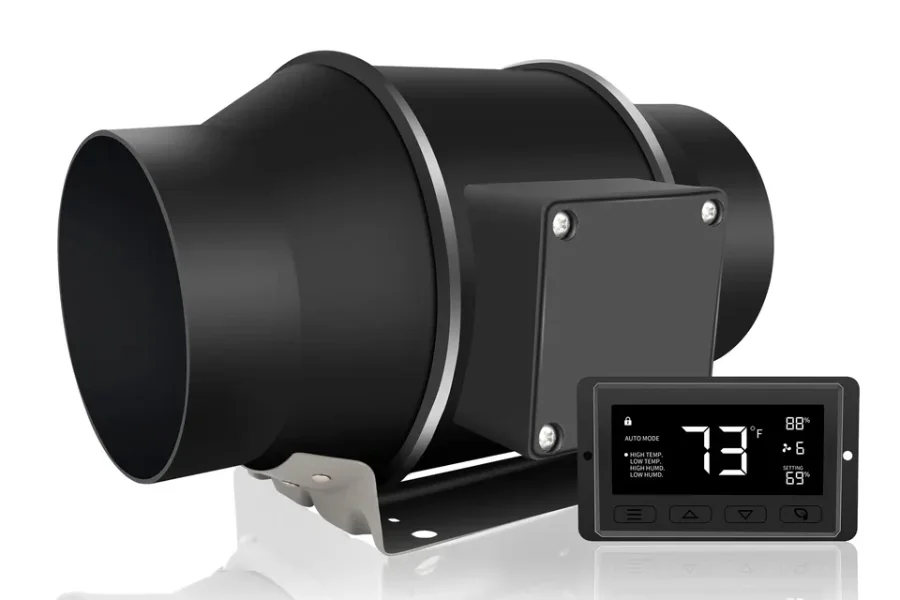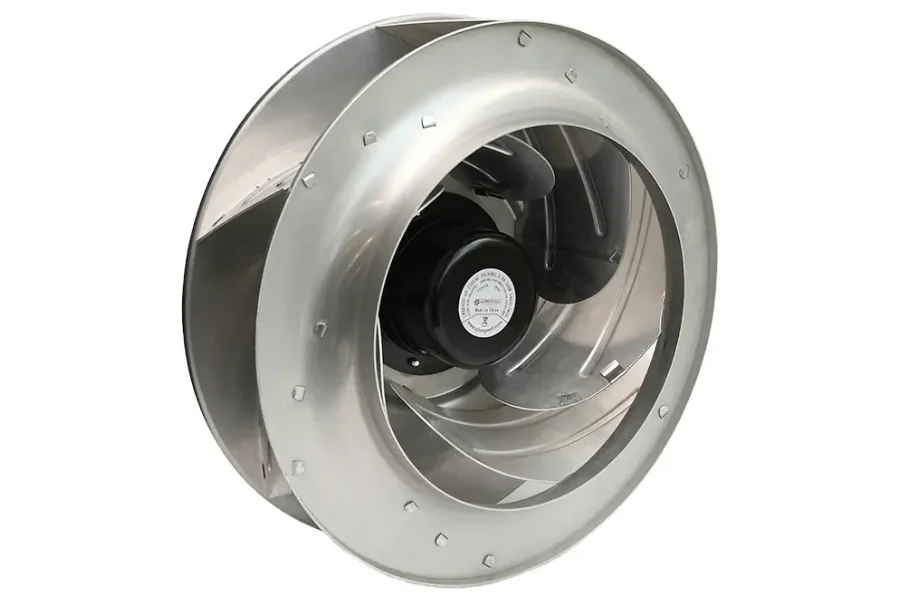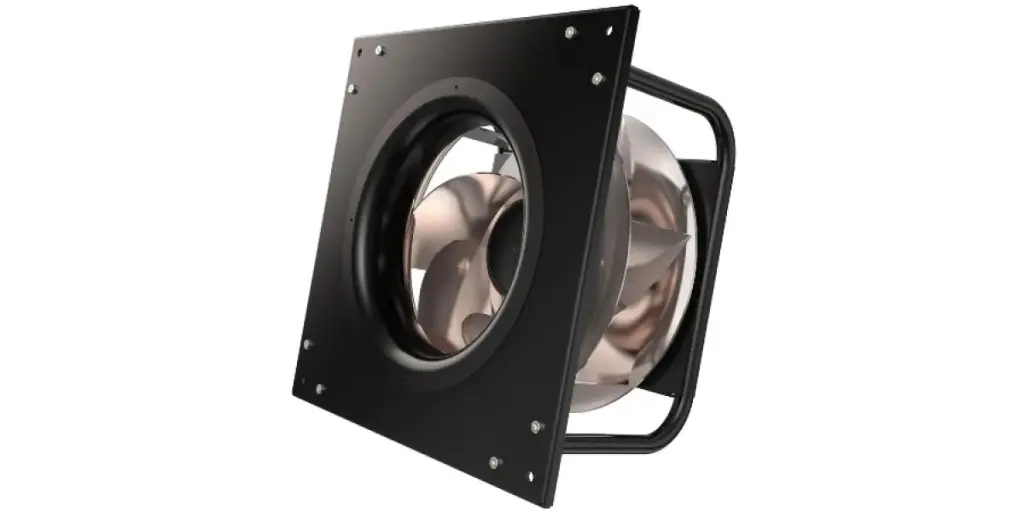Electronically commutated motor (ECM) fans, defined by their unique advanced motor technology and electronic control systems, stand out for their superior performance. They utilize brushless DC motors, which allow variable speed control and quieter operation. This means they offer energy efficiency and precise control, revolutionizing the cooling and ventilation industry.
This article will reveal the benefits of these state-of-the-art ECM fans for buyers. The global market share of these fans will be discussed, including the market segments and the key players. And finally, the key factors for choosing an ECM fan will be discussed so buyers and retailers can select ECM fans that meet their cooling needs as they optimize energy consumption.
Table of Contents
Electronically commutated fans market
Market prospects and development trends
How electronically commutated motors fans work
Basic concepts and characteristics of ECM fans
The ultimate guide to buying electronically commutated motor fans
Summary
Electronically commutated fans market

Generally, the ECM fans market is segmented based on types (axial, centrifugal, mixed flow, cross flow), applications (food processing, marine, manufacturing, telecom automotive), and regions. The market is expanding steadily due to key players’ increasing strategy and advanced technology adoption. Some major global ECM fan manufacturers include Continental Fan, ECOFIT, Hidria, and Delta Electronics Inc.
According to Research and Markets, the global ECM fans market size was USD 550.9 million in 2021. The market was estimated to expand to USD 935.6 million by 2031. This growth would be based on a continuous annual growth rate of about 5.4% during the forecast period. This is due to manufacturers’ increased spending on research and development to produce more advanced and efficient ECM fans.
Regionally, the ECM fans market in Asia Pacific is expected to experience the fastest expansion during the forecast period. Most industries are shifting their manufacturing plants to the Asia Pacific block, with China being the largest market for ECM fans. Additionally, manufacturers are expanding their product lines to meet the rising demand for ECM fans depending on consumer requirements.
Market prospects and development trends

The ECM fans market is experiencing a significant growth trajectory. This is ascribed to the rising demand for energy-efficient and environmentally friendly ventilation systems. ECM fans are the game changer due to sustainability and energy conservation. This shifts focus towards greener and more efficient technologies. Below are the anticipated market prospects and development trends for ECM fans:
- Increased adoption – ECM fans are presently applied across several residential, industrial, and commercial sectors. Regarding regulations on minimizing carbon footprints, homeowners and businesses prefer ECM fans over traditional fans and motors. The resulting demand is expanding the market and bringing new opportunities for manufacturers.
- Focus on customization and integration – manufacturers intend to offer tailored solutions to meet specific requirements from different applications. For instance, HVAC (Heating, Ventilation, and Air Conditioning), management systems, and other cooling technologies.
- Cost savings and energy efficiency – ECM fans have remarkable energy conservation features. In contrast to conventional fans, ECM fans save energy which translates into decreased operating costs for buyers. Also, as energy prices increase, businesses prioritize sustainability and opt for ECM fans for cost-effectiveness.
- Enhanced performance and durability – manufacturers are heavily investing in research and development to boost the performance and durability of ECM fans. There are advancements in motor designs, materials, and aerodynamics. These features increase airflow, quieter functioning, and longer service life.
- Smart and connected solutions – ECM fans are integrated with the Internet of Things (IoT) platforms and advanced control systems. This enables scheduling, remote monitoring, and intelligent automation. The features improve user convenience, boost performance, and enable predictive maintenance, which drive the demand for ECM fans in homes and smart buildings.
- Emerging markets and sustainability initiatives – sustainability has become a global priority leading to a surge in demand for ECM fans in emerging markets. Most industries opt for energy efficiency and environmental responsibility, which presents growth opportunities for ECM fan producers. This has expanded their presence globally and contributed to sustainable development initiatives.
How electronically commutated motors fans work

ECM fans function via a complex yet efficient process. The process involves a brushless DC motor and electronic control. Below is the detailed process of how ECM fans operate:
- Power supply – the ECM fan is connected to a power source, mostly an AC power line. This power is converted and regulated via an onboard power supply unit that ensures appropriate voltage and current levels for the fan’s proper functioning.
- Electronics control – the control electronics receive commands and signals from external sources like sensors, thermostats, or control systems. These built-in sensors manage humidity, temperature, and pressure.
- Stator and rotor – the brushless DC motor consists of a stationary component called the stator and a rotating component called the rotor. The stator has multiple sets of windings in three phases that are energized to generate rotating magnetic fields.
- Commutation – this is the critical difference between traditional AC fans and ECM fans. ECM fans use electronic commutation to switch the current flow. In this case, the control electronics monitor the speed and position of the rotor via sensor feedback or estimation algorithms for internal rotor positioning.
- Pulse Width Modulation (PWM) – ECM fans utilize this feature to control the torque and speed of the motor. Control electronics adjust the pulse width and frequency of the stator windings’ current to regulate the power supplied to the motor effectively.
- Magnetic field interaction – a magnetic field is created when the current flows through the stator windings. The rotor has permanent magnets which interact with the magnetic field to rotate.
- Variable speed control – as the control electronics alter the frequency and amplitude of the current pulses, they precisely control the speed and direction of the rotor. This allows ECM fans to produce airflow at different rates to attain cooling and ventilation requirements.
Basic concepts and characteristics of ECM fans

- Motor technology – ECM fans use brushless DC motors with electronically controlled stator windings and a permanent magnet rotor. The absence of commutators and brushes reduces friction, which boosts reliability and drives overall motor effectiveness.
- Energy efficiency – the brushless DC motor feature and precise motor speed control allow ECM fans to optimize airflow as they consume less power. This reduces operating costs and saves energy significantly.
- Quiet operation – eliminating brushes and employing advanced motor technology reduces mechanical noise. Also, the fan speed is controlled for a quieter operation with minimal audible disturbances in commercial, residential, and industrial settings.
- Easy integration – EMC fans are structured for easy integration into existing systems. The standard mourning options allow them to be retrofitted into applications that previously employed AC fans. As such, upgrading traditional fan systems to more controllable and efficient EMC fans is easy.
- Intelligent control – most ECM fans are designed with intelligent control components. They can be operated via dedicated fan controllers or integrated into building management programs. The ECM fans with built-in sensors provide data on humidity, temperature, and pressure for speed automation and adjustments depending on the environmental conditions.
The ultimate guide to buying electronically commutated motor fans
1. Power
As buyers acquire ECM fans, they should consider the power requirements. On average, these fans have power ratings ranging from a few watts to several hundred watts. The power ratings influence the fan’s speed range, size, airflow capacity, and application requirements.
Smaller ECM fans in small commercial and residential applications have an average power rating of about 5 to 50 watts. The larger ECM fans applied in commercial and industrial settings have power ratings of about 50 to 500 watts. Buyers should select the appropriate power to ensure optimal performance and avoid underutilization and overloading of the fan.
2. Motor size
ECM fans’ motor size depends on airflow requirements and space limitations. On average, smaller ECM fans have a motor size range of approximately 60 mm to 120 mm in diameter. They are used in smaller ventilation applications and HVAC systems.
Larger ECM fans with a motor size range of about 120 mm to 400 mm are used for larger commercial and industrial environments. Buyers should consult the manufacturers for the correct specifications and guidelines on the appropriate motor size for their desired airflow needs.
3. Cost
Buyers should consider the cost of the ECM fans based on their features, energy efficiency, and long-term savings. Light commercial and smaller residential ECM fans tend to cost cost around USD 20 to USD 50.
Larger industrial and commercial ECM fans cost between USD 50 and USD 500. Generally, high-quality ECM fans have higher upfront costs but offer substantial energy savings and durability. Buyers must conduct a cost-benefit analysis to determine the appropriate investment value, including energy efficiency, maintenance costs, and estimated service life.
4. Compatibility
The selected ECM fan should be compatible with the existing system or intended application. Factors like voltage requirements, physical dimensions, and control interfaces should be considered.
Buyers should verify that the ECM fan they prefer can seamlessly integrate into their systems without needing extensive modifications and additional components. Generally, compatibility allows for smooth installation and improves performance.
5. Efficiency
Efficiency is a significant benefit of ECM fans. Buyers should assess the fan’s energy efficiency ratings as metrics like the Airflow Efficiency Ratio indicate. Also, the fan’s power consumption compared to its airflow output shows its efficiency.
The AFER rating for ECM fans averages 2 and 4 or higher. Higher efficiency results in reduced energy consumption and lesser operating costs. As such, buyers should seek ECM fans with high AFER values to meet the efficiency standards and certifications.
6. Durability
The reliability and durability of fans should be evaluated carefully. This is based on construction quality, materials, and other features. On average, a fully functional ECM fan has a service life of between 5 and 10 years.
As such, buyers should look for fans with features like sealed bearings, corrosion-resistant coatings, and thermal protection mechanisms. These factors ensure longevity and reliable operations in demanding settings.
7. Speed
The ECM fans have a variable speed control feature that alters the fans’ speed depending on the cooling requirements. The smaller residential and commercial EMC fans have an average speed range of about 1,000 RPM to 2,500 RPM. Additionally, the average speed of larger commercial and industrial EMC fans ranges from 500 RPM to 2,000 RPM.
The speed range and the fan’s ability to change smoothly between speeds should be considered. Buyers should acquire fans that offer a wide speed range with precise speed control that match the specific application’s needs.
8. Application cases and successful experiences
Buyers must research and collect information on application cases and successful experiences with ECM fans. Case studies, customer testimonials, and expert reviews give insights into the practical implementations and the benefits attained.
Buyers can make informed decisions based on their specific applications when they understand how ECM fans have been utilized successfully. They have beforehand information on overall fan performance, energy savings, and satisfaction.
Summary
Electronically commutated motor fans offer a technologically advanced and sustainable solution to a client’s HVAC needs. This guide has highlighted the essential factors that retailers should consider to ensure they are sourcing the right ECM fans for their target market. To explore a range of listings of ECM fans and their key components, and to learn more about sourcing trends and tips, visit Alibaba.com.




